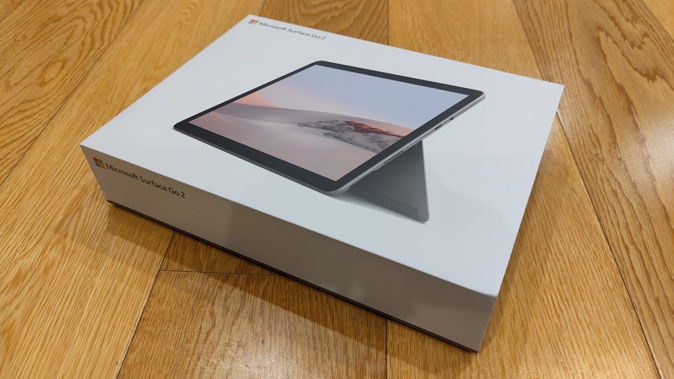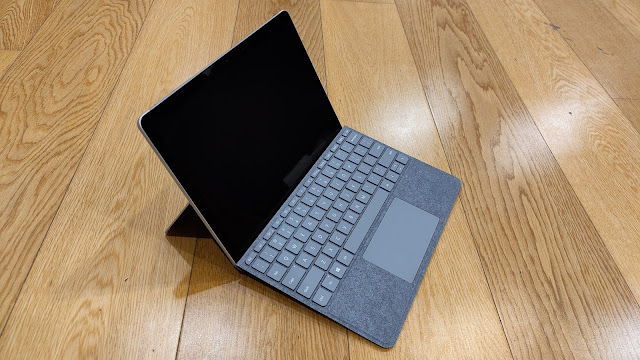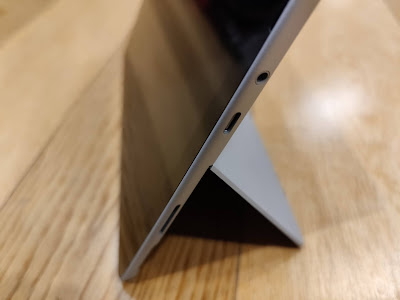
Microsoft's range of Surface devices keeps evolving, expanding and improving.
As a general concept, I've always been a big fan of the Surface's unique form factor; a tablet with a built-in kick-stand and a detachable keyboard cover.
On the other hand, I have had issues with various Surfaces over the years - some have been woefully underpowered processor-wise, far more expensive than they should be, often with bad battery performance to boot.
On the other other hand, more recently I've had nothing but great experiences and have found the last few Surface Pros to be sublime examples of mobile computing design.
So where does the new little brother fit in?...
If you've used any Microsoft Surface before, the Surface Go 2 will feel strikingly familiar - just a bit smaller. That is, unless you've been using the original Surface Go. The second generation has a slightly larger screen than that of its predecessor - now clocking in at 10.5" yet the device itself is not really any bigger. This means smaller bezels around the edges - not tiny bezels mind you, we're still talking about 1cm of unused blackness top, sides and bottom but it's definitely an improvement.
Because the Surface is designed to be used with its magnetised type cover as well as being a tablet, the cameras are on the long side and they're surprisingly good cameras too. A 5MP front-facing lens and an 8MP rear lens, both capable of 1080p shooting and with many phone-camera style options like HDR and panorama. Instead of a frustratingly limited photo experience, as you're likely to find on most laptops and tablets, you can actually shoot some half decent pics and vids with the Surface Go 2.
In fact, the multimedia experience the Surface Go 2 provides is first-rate - not only is the 3:2 Pixelsense display bigger, it's a pleasure to watch and the speakers are impressively powerful with good bass response. Dual stereo mics make this a great device for video conferencing too.
Which all dovetails nicely into its general usefulness as BYOD for school or uni. It really is super light and compact, barely noticeable when slipped into a schoolbag or backpack.
While the Surface Go 2 only comes in one colour, Platinum, there are different options available for the type cover, Surface pen and Surface mouse; including Ice Blue, Poppy Red and plain old black. None of these accessories come in the box of course but we'll get to that shortly. Unfortunately, this is where the Surface Go 2's biggest strength becomes its biggest weakness; it's small. That's great. But it also means the type cover is small too - the keys are smaller and the whole keyboard is more narrow than standard. This not only means you get the feeling your wrists are being squashed together while you type but I've also found myself mistyping. A lot. I'd say this issue will improve with more use as muscle memory kicks in but it's definitely an issue.
As usual for a Surface, Microsoft hasn't exactly gone overboard with the selection of ports - in fact, other than the magnetic power (Surface Connect) slot, there are just three; a headphone jack, a microSD slot and a USB-C port. This is a trend we're seeing across the board, most manufacturers moving towards wireless connectivity via bluetooth and WiFi accessories. To be fair, Windows makes projecting your display to a wireless monitor or smart TV pretty easy these days, so not having some kind of universal display-out port isn't the end of the world.
The Surface Go 2 is the first device I've reviewed with Windows 10 S Mode installed. This is a version of Windows designed especially for more entry-level, lower specced devices like the Surface Go 2. The idea is to enhance security and improve speed and performance by restricting users to apps only available on the Microsoft Store. This helps with loading times and ensures you're only installing purpose-built content, not forcing the device to run programs designed for more powerful processor or graphics configurations.
At first, I was a little nervous. I'm not a fan of Microsoft Edge as a default browser but in S Mode it's your only choice - although in saying that, the new version of Edge is based on Chromium and as such, it's a breath of fresh air. I encourage you to give it a try.
What I was surprised to discover is just how many apps I use already are available on the Microsoft Store. This is by no means a barren, insular wasteland of Microsoft-only software you normally wouldn't use unless you had to. Messenger, iTunes, Netflix, Spotify... all these are available and easily installed.
On the other hand, if I was to consider using the Surface Go as my primary work device, I'd need to be able to install more full-on tools like Adobe Audition - a no go in S Mode. Thankfully, you can exit out of S Mode with just a couple of clicks, although strangely this is a one-way option, you can't go back if you have second thoughts. Even more strangely, I've noticed almost no difference since flicking into Windows 10 Home, other than I can now install all the apps I need.
As a result, using the Surface Go 2 is now pretty much a fantastic experience all round. It runs my Adobe Audition projects without issue - even syncing my cloud-based audio files while I'm editing. Obviously this is no gaming-level powerhouse but I'd be surprised if too many people expected to run Red Dead Redemption on a 10.5" tablet.
Microsoft has improved battery life on the Surface Go 2 but not enough to make it a feature worth skiting about. The website claims up to ten hours of "ordinary use." Their idea of what's ordinary must be a lot more ordinary than mine because I never got near ten hours before having to plug in the charger. You should get through a day of school okay but not by much.
My biggest issue with any Microsoft Surface has always been the price and unfortunately, the Surface Go 2 does nothing to change my view on this. At $729 as a starting point, it might not seem too pricey - but remember, that doesn't include the type cover, mouse or Surface Pen. At that price you're also only getting 64GB of eMMC storage and 4GB of RAM. Given the limitations I've already described using the 8GB version, I wouldn't feel comfortable recommending you go for half the processing power. Add the type cover and the extra RAM and 128GB of SSD storage, suddenly the price tag immediately leaps to over $1200. At that price point, there are probably full-size laptop options out there with even better specs so you're really only paying for the Surface Go's great portability and unique form factor. That's not a reason to not buy it, just the choice you need to make.
In the configuration I've been using I've experienced no real limitations in my day-to-day computing other than having to deal with the undersized keyboard, a small (excuse the pun) price to pay for the extreme mobility and comprehensive multimedia performance of this device. At the end of the day I love the Surface form factor and if you do too, then its slightly inflated price tag is just about worth it.
Click here for more information and pricing on the Microsoft Surface Go 2.
Take your Radio, Podcasts and Music with you













